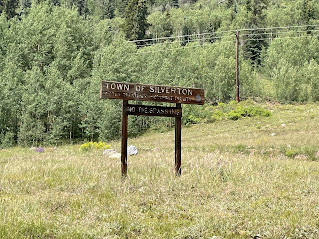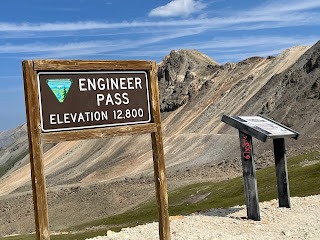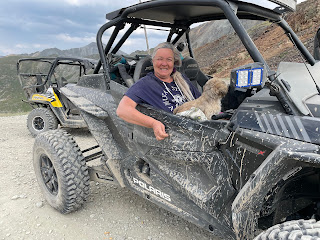On August 8-11 we went on a trip to Silverton, Colorado with
some of our awesome friends--
Jim & Vicki Orr
Bruce & Patti Lyman
Brent & Susan Flavel
David & Susanne Johnson
Mylon & Brenda Munson
Bev & Dale Black
Jeroldene Helquist
We set up our jumping jack tent in a campground
that had all the facilities (running water, showers & bathrooms) to make our stay comfortable
and fun.
The first thing to catch our attention was "The Christ of Mines Shrine" up on the hillside overlooking Silverton. After attending sacrament meeting
and Sunday School class, we decided to go visit this interesting monument.
I was curious about this "shrine" looked it up. This is what I learned:
The Christ of the Mines Shrine is a 12-ton, 16-foot tall statue of Jesus Christ,
which sits on the foothills of Anvil Mountain, In Silverton, Colorado.
During the 1950's the mining industry in Silverton hit rock bottom, mines were shutting every where within the San Juan Mountains. In 1958, the idea of a shrine dedicated to the miners was developed.
A few months after the Shrine was completed, the American Tunnel was started, which
provided access into the lower reaches of the Sunnyside Mine. Mining in Silverton once again flourished.
The next addition to the Shrine were the trees behind it. St Patrick's Parish purchased 1,000 Scotch Pine seedlings and planted them in back of the shrine. Today a mini-forest of Scotch Pines grace the back side of the Shrine.
A disaster occurred in 1978 whereby Lake Emma broke through the Sunnyside Mine. The water flooded through the underground workings and out the lower portal, destroying everything in its path. Fortunately the flooding occurred on a Sunday night when no men were working. Although the mine shut down for a while, no lives were lost due to the flooding.
Silverton's Christ of the Mines Shrine is a constant reminder of the importance of the Mining Industry and especially the miners who worked underground.
Our next place to visit was the Hillside Cemetery of Silverton.
It was a very touching experience to wander through the
cemetery and read about the people who were buried there.
They had a very hard life and some of them died tragic deaths
related to the work in the mines or just connected
to the hard life they lived.
From the Hillside Cemetery Website:
Hillside Cemetery lies a little north of Silverton, past the courthouse, on the steep lower slope of Boulder Mountain. There are no winding paths between the graves and the plots are not laid out in neat and orderly rows. This venerable old burying ground, a place of wild grandeur and rare beauty, is sprawled over twenty acres on the side of the rugged mountain. At an altitude of more than 9,300 feet, the cemetery is constantly struggling against the harsh elements of nature which endlessly threaten to damage tombstones, rock walls and fences. There are no winding paths between the graves and the plots are not laid out in neat and orderly rows. This venerable old burying ground, a place of wild grandeur and rare beauty, is sprawled over twenty acres on the side of the rugged mountain. At an altitude of more than 9,300 feet, the cemetery is constantly struggling against the harsh elements of nature which endlessly threaten to damage tombstones, rock walls and fences. The landscaping, designed by nature, is beautiful and natural, with numerous aspen, spruce and pine trees. In the summer, masses of daisies interspersed with red, blue, purple and yellow wildflowers, decorate the graveyard. In winter, deep snows blanket the graves of those who sleep eternally at Hillside. Above, the magnificent mountains stand as eternal, silent sentinels encircling the cemetery and little town below.
Wandering through the cemetery you begin to absorb the human history of the area. The tombstone inscriptions reveal bits and pieces of individual personalities, religious preferences, places of birth, causes of death, and the difficulties of frontier life. Here is evidence of the scourges of pneumonia, typhoid fever, scarlet fever, diphtheria, and the devastating flu epidemic of 1918. Childhood diseases carried to an early death an alarming number of babies and young children.
The cemetery also bears grim witness to the special hazards of childbirth in a primitive and hostile environment, as well as the extreme and deadly dangers encountered in the early days of hard rock mining in the high country


Other days we rode our "machines" and explored this beautiful area.
There were many old mines that were interesting and intriguing!!
It was absolutely gorgeous wherever we went!!

On our last night in camp, this train passed close by,
blowing its horn as if to say goodbye.
We were sad when we realized it was time to head home.
What a fun week with our friends :)









































0 comments:
Post a Comment